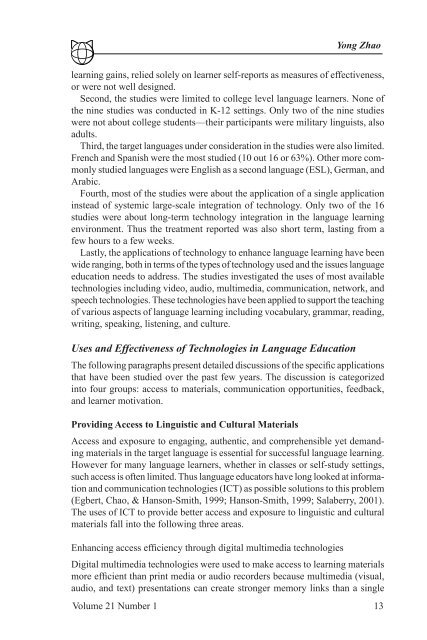Recent Developments in Technology and Language ... - CALICO
Recent Developments in Technology and Language ... - CALICO
Recent Developments in Technology and Language ... - CALICO
Create successful ePaper yourself
Turn your PDF publications into a flip-book with our unique Google optimized e-Paper software.
Yong Zhao<br />
learn<strong>in</strong>g ga<strong>in</strong>s, relied solely on learner self-reports as measures of effectiveness,<br />
or were not well designed.<br />
Second, the studies were limited to college level language learners. None of<br />
the n<strong>in</strong>e studies was conducted <strong>in</strong> K-12 sett<strong>in</strong>gs. Only two of the n<strong>in</strong>e studies<br />
were not about college students—their participants were military l<strong>in</strong>guists, also<br />
adults.<br />
Third, the target languages under consideration <strong>in</strong> the studies were also limited.<br />
French <strong>and</strong> Spanish were the most studied (10 out 16 or 63%). Other more commonly<br />
studied languages were English as a second language (ESL), German, <strong>and</strong><br />
Arabic.<br />
Fourth, most of the studies were about the application of a s<strong>in</strong>gle application<br />
<strong>in</strong>stead of systemic large-scale <strong>in</strong>tegration of technology. Only two of the 16<br />
studies were about long-term technology <strong>in</strong>tegration <strong>in</strong> the language learn<strong>in</strong>g<br />
environment. Thus the treatment reported was also short term, last<strong>in</strong>g from a<br />
few hours to a few weeks.<br />
Lastly, the applications of technology to enhance language learn<strong>in</strong>g have been<br />
wide rang<strong>in</strong>g, both <strong>in</strong> terms of the types of technology used <strong>and</strong> the issues language<br />
education needs to address. The studies <strong>in</strong>vestigated the uses of most available<br />
technologies <strong>in</strong>clud<strong>in</strong>g video, audio, multimedia, communication, network, <strong>and</strong><br />
speech technologies. These technologies have been applied to support the teach<strong>in</strong>g<br />
of various aspects of language learn<strong>in</strong>g <strong>in</strong>clud<strong>in</strong>g vocabulary, grammar, read<strong>in</strong>g,<br />
writ<strong>in</strong>g, speak<strong>in</strong>g, listen<strong>in</strong>g, <strong>and</strong> culture.<br />
Uses <strong>and</strong> Effectiveness of Technologies <strong>in</strong> <strong>Language</strong> Education<br />
The follow<strong>in</strong>g paragraphs present detailed discussions of the specific applications<br />
that have been studied over the past few years. The discussion is categorized<br />
<strong>in</strong>to four groups: access to materials, communication opportunities, feedback,<br />
<strong>and</strong> learner motivation.<br />
Provid<strong>in</strong>g Access to L<strong>in</strong>guistic <strong>and</strong> Cultural Materials<br />
Access <strong>and</strong> exposure to engag<strong>in</strong>g, authentic, <strong>and</strong> comprehensible yet dem<strong>and</strong><strong>in</strong>g<br />
materials <strong>in</strong> the target language is essential for successful language learn<strong>in</strong>g.<br />
However for many language learners, whether <strong>in</strong> classes or self-study sett<strong>in</strong>gs,<br />
such access is often limited. Thus language educators have long looked at <strong>in</strong>formation<br />
<strong>and</strong> communication technologies (ICT) as possible solutions to this problem<br />
(Egbert, Chao, & Hanson-Smith, 1999; Hanson-Smith, 1999; Salaberry, 2001).<br />
The uses of ICT to provide better access <strong>and</strong> exposure to l<strong>in</strong>guistic <strong>and</strong> cultural<br />
materials fall <strong>in</strong>to the follow<strong>in</strong>g three areas.<br />
Enhanc<strong>in</strong>g access efficiency through digital multimedia technologies<br />
Digital multimedia technologies were used to make access to learn<strong>in</strong>g materials<br />
more efficient than pr<strong>in</strong>t media or audio recorders because multimedia (visual,<br />
audio, <strong>and</strong> text) presentations can create stronger memory l<strong>in</strong>ks than a s<strong>in</strong>gle<br />
Volume 21 Number 1 13
















